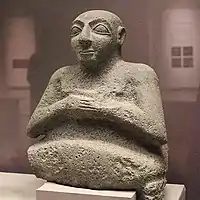Tell al-'Ubaid
Tell al-'Ubaid (Arabic: العبيد) is a low, relatively small tell (settlement mound) west of nearby Ur in southern Iraq's Dhi Qar Governorate. The majority of the remains are from the Chalcolithic Ubaid period, for which Tell al-'Ubaid is the type site, with an Early Dynastic temple and cemetery at the highest point.
 Tell al-'Ubaid | |
 Shown within Iraq | |
| Location | Dhi Qar Province, Iraq |
|---|---|
| Region | Mesopotamia |
| Coordinates | 30°58′20″N 46°01′50″E |
| Type | tell |
| Site notes | |
| Excavation dates | 1919, 1923, 1924, 1937 |
| Archaeologists | H. Hall, C. L. Woolley, S. Lloyd, P. Delougaz |
History of archaeological research
The site was first worked by Henry Hall of the British Museum in 1919.[1] Later, C. L. Woolley excavated there in 1923 and 1924,[2] followed by Seton Lloyd and Pinhas Delougaz in 1937, the latter working for the Oriental Institute of the University of Chicago.[3][4]
Tell al-'Ubaid and its environment
Today, Tell al-'Ubaid lies 250 kilometres (160 mi) from the Persian Gulf, but the shoreline lay much closer to the site during the Ubaid period. The tell, or settlement mound, is an oblong measuring approximately 500 by 300 metres (1,640 ft × 980 ft) on a roughly north-south axis. It extends about 2 metres (6 ft 7 in) above the current surface. The excavated Early Dynastic temple is located on the northern edge of the site.[5] A cemetery was also found with 96 graves, mostly from the Early Dynastic Period.[6]
Occupation history
The lower level of the site featured large amounts of Ubaid pottery and associated kilns. Evidence for Ubaid period pottery manufacture has also been observed on the surface of the site. The size of the surface scatter indicates that pottery production was a specialized craft, and this confirms finds from other Ubaid sites like Eridu.[5] The site also yielded a cemetery and some finds from the Jemdet Nasr period. The temple of Ninhursag at the summit was on a cleared oval similar to that at Khafajah. The wall surrounding the temple was built by Shulgi of the Ur III Empire.
Gallery
 Stone statue of Kurlil, Early Dynastic III, 2500 BC Tell Al-'Ubaid
Stone statue of Kurlil, Early Dynastic III, 2500 BC Tell Al-'Ubaid Parts of mosaic columns from the entrance to the Temple of Ninhursag at Tell al-'Ubaid, Iraq, 2800-2600 BCE. Iraq Museum
Parts of mosaic columns from the entrance to the Temple of Ninhursag at Tell al-'Ubaid, Iraq, 2800-2600 BCE. Iraq Museum Recumbent cow, part of a frieze once decorated the facade of the Temple of Ninhursag at Tell al-'Ubaid, Iraq, 2800-2600 BCE. Iraq Museum
Recumbent cow, part of a frieze once decorated the facade of the Temple of Ninhursag at Tell al-'Ubaid, Iraq, 2800-2600 BCE. Iraq Museum Sumerian scene, milking cows and making dairy products. From the facade of the Temple of Ninhursag at Tell al-'Ubaid, Iraq, 2800-2600 BCE. Iraq Museum
Sumerian scene, milking cows and making dairy products. From the facade of the Temple of Ninhursag at Tell al-'Ubaid, Iraq, 2800-2600 BCE. Iraq Museum
See also
| Wikimedia Commons has media related to Tell Al-Ubaid. |
References
- H. R. Hall, Season's Work at Ur; Al-'Ubaid, Abu Shahrain (Eridu), and Elsewhere; Being an Unofficial Account of the British Museum Archaeological Mission to Babylonia, 1919, Methuen, 1930
- Hall, H. R.; Woolley, C. L. (1927). UR Excavations Volume I Al-'Ubaid. Oxford University Press.
- Delougaz, P. (1938). "A Short Investigation of the Temple at Al-'Ubaid". Iraq. 5: 1–11. doi:10.2307/4241617.
- Seton Lloyd, Ur-al 'Ubaid, 'Uqair and Eridu. An Interpretation of Some Evidence from the Flood-Pit, Iraq, ol. 22, Ur in Retrospect. In Memory of Sir C. Leonard Woolley, pp. 23-31, (Spring - Autumn, 1960)
- Moore, A.M.T. (2002). "Pottery Kiln Sites at al 'Ubaid and Eridu". Iraq. 64: 69–77. JSTOR 4200519.
- Harriet P. Martin, The Early Dynastic Cemetery at al-'Ubaid, a Re-Evaluation, Iraq, vol. 44, no. 2, pp. 145-185, 1982
